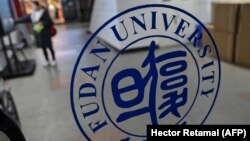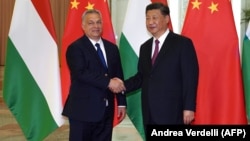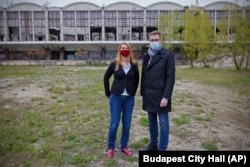
Welcome back to the China In Eurasia briefing, an RFE/RL newsletter tracking China’s resurgent influence from Eastern Europe to Central Asia.
Big news! The China In Eurasia newsletter will now be going out twice a month. Expect to see it in your inbox on the first and third Wednesdays of each month. I’m RFE/RL correspondent Reid Standish and here’s what I’m following right now.
China Takes Center Stage In Europe
Debt problems and transparency concerns pushed Beijing’s projects across Europe into the spotlight this month. A controversial Beijing-financed highway project in Montenegro and a $1.5 billion loan to build a Chinese university in Hungary have rung alarm bells in Brussels as both ventures pointed to growing influence within the European Union and on its doorstep.
Finding Perspective: Hungary signed a deal with Shanghai’s prestigious Fudan University in late April that would open a campus in Budapest by 2024.
Leaked documents show that the campus will cost $1.8 billion and that the Hungarian government will take out a $1.5 billion Chinese loan to cover the majority of the cost.
The plans are controversial for a host of reasons, as I reported this week with my colleague Akos Keller-Alant from RFE/RL’s Hungarian Service.
Opposition politicians in Hungary raised concerns over potential debt problems and that Hungarian taxpayers are footing the bill for a private Chinese university, pointing out that the proposed project will cost more than what the government spends annually on higher education across the entire country.
Many details around the project and the Chinese loan are also hidden, which Budapest Mayor Gergely Karacsony told us is one of the reasons why he’s trying to block the campus from being built.
Meanwhile, Montenegro asked the EU in April for help in paying back its $1 billion debt to China for a still-to-be-completed highway to Serbia, which I explored in an article with Asja Hafner, Gjeraqina Tuhina, and Slavica Brajovic from RFE/RL’s Balkan Service.
The EU rebuffed those calls to help pay off the loan, which was signed by the previous government, leaving the cash-strapped Balkan country in a precarious situation as its first debt payments are due this summer.
Why It Matters: Both cases point to rising concern in Brussels (and Washington) over Chinese lending practices and debts, which could open the door to further political and economic influence by Beijing.
But the examples also highlight the role that Chinese cash occupies in domestic politics.
In Hungary, China is a useful card for Prime Minister Viktor Orban to play in his standoff with the EU. His strong relationship with Beijing has also given him cover as the country’s democratic institutions have eroded under his watch.
Read More
- My colleague Predrag Tomovic from RFE/RL’s Balkan Service looked at details of the contract that Montenegro signed with the Export-Import Bank of China, focusing on the clause that could allow the bank to seize assets if the government can’t meet its debt payments.
- For added context on what’s motivating ties between Beijing and Budapest, this quote from my interview with Tamas Matura, an assistant professor at Corvinus University in Budapest, is illuminating: "None of these ideas are coming from China. They are coming from the Hungarian side, but, of course, Beijing is happy to go along with them.”
- RFE/RL’s Hungarian Service spoke with local expert Gyorgy Tilesch about security concerns over Budapest hosting Fudan University, which has known ties to China’s intelligence services.
Expert Corner: Europe Between Beijing And Washington
Readers asked: “Is Europe becoming the new dividing line between China and the United States?”
"Europe sees itself as a moderating force in the escalating competition between the United States and China. For economic and political reasons, it is pushing back against the notion of a zero-sum world and refusing to choose sides. Walking this geopolitical tightrope will be increasingly challenging. China may welcome a nonaligned Europe, but U.S. politicians will find it very difficult to swallow." -- Noah Barkin, author of the German Marshall Fund’s Watching China In Europe newsletter and managing editor with Rhodium Group's China practice
Do you have a question about China’s growing footprint in Eurasia? Send it to me at StandishR@rferl.org and I’ll get it answered by leading experts and policymakers.
Three More Stories From Eurasia
1. Playing The Long Game
Beijing is preparing for fallout from U.S. President Joe Biden’s decision to withdraw American troops from Afghanistan, where China is looking to wield more influence but is cautious about getting too involved in the country’s chaos.
Evolving Interests: China shares a 76-kilometer border with Afghanistan and has preferred a low-key approach toward its unstable neighbor, but that’s slowly changing, which I wrote about with my colleague Ajmal Aand from RFE/RL’s Radio Free Afghanistan.
Beijing’s main concern is about Afghanistan becoming a haven for Uyghur radicals and other fundamentalists angered by Beijing’s repressive policies toward ethnic Muslim minorities in Xinjiang to launch a cross-border insurgency.
China has also been lured by Afghanistan’s mineral riches, with Chinese companies announcing investments worth billions of dollars in copper mining and oil exploration, although ongoing instability has left those ventures on hold.
Reality Check: China will look to ramp up its diplomatic efforts and protect its interests, but the country has no desire to fill the vacuum left by the United States in Afghanistan.
2. Xinjiang Continues To Ripple Across Eurasia
The fallout from China’s ongoing internment of Uyghurs, Kazakhs, and other Muslim minorities in its western Xinjiang region continues to reverberate across Central Asia and beyond.
The Local: As RFE/RL’s Kazakh Service reported, three ethnic Kazakhs who claimed asylum in Kazakhstan after crossing the border illegally from Xinjiang are asking the government for permission to leave the country.
Despite receiving temporary asylum, none of the three people are able to work legally in the country and have no path to citizenship or permanent residency under Kazakh law. In the face of these difficulties, they’re pushing the Kazakh government to allow them to leave for a third country.
Meanwhile, Raqyzhan Zeinolla, a 58-year old naturalized Kazakh citizen, was released in April after being imprisoned in China for 17 years. Zeinolla was arrested in 2004 during a visit to Xinjiang and accused of being a spy, where he then did stints in prison and a so-called “reeducation camp.”
The Global: The watchdog group Human Rights Watch declared in April that the Chinese government is committing crimes against humanity against Uyghurs and other groups in Xinjiang.
The Rand Corporation also released a new study where the authors examined satellite photos of Xinjiang to show the massive expansion of detention facilities in the area.
3. Deciphering The Belt And Road
China is the world's largest official creditor, but many of the basic facts around Beijing's foreign lending are still unknown.
In the hopes of pulling the curtain back on these practices, I interviewed Scott Morris, one of the authors of a recent study by the Center for Global Development that did a first-of-its-kind analysis of 100 Chinese contracts across 24 developing countries in Africa, Asia, Europe, and Latin America.
Main Takeaways: The study finds that Chinese contracts have a host of unique features that are unusual even for the murky world of international lending.
A strong reliance on secrecy is common among Chinese contracts, while many deals contain clauses that prevent collective-debt restructuring and allow Beijing to cancel debt or accelerate repayments, which Morris says could potentially influence the policies of debtor countries.
Despite the restrictive nature of the deals, Morris pushes back on so-called “debt-trap diplomacy,” the idea that Beijing is deliberately trying to get countries into debt in order to increase its influence over them.
Instead, he says that after the analysis of the contracts, it’s clear that “Chinese entities are issuing loans with the full intention of getting their money back.”
Across The Supercontinent
It's Chinatown: A Tajik city bulldozed 30 houses on a picturesque riverbank for a huge Chinese-funded project comprising 1,200 apartment units, a school, car park, and various stores.
My colleague Farangis Najibullah looked at how, six years later, 300 evicted people are still waiting for promised housing.
Front Of The Line: RFE/RL’s Ukrainian Service is investigating how Chinese citizens living in Ukraine were vaccinated en masse against COVID-19, while the rest of the country’s rollout continues to move slowly.
Sinopharm Arrives: North Macedonia’s struggling vaccination program got a boost with the arrival of 200,000 doses of China’s Sinopharm vaccine, RFE/RL's Balkan Service reported.
About 500,000 doses of Sinovac, another Chinese vaccine, are supposed to arrive later this month.
Perception Gap: Despite being outspent by the EU, a majority of Serbs believe that China is the largest provider of aid to Serbia to combat the pandemic -- although Iva Martinovic from RFE/RL’s Balkan Service reports that this is changing.
According to a recent study, 56.4 percent of Serbs believe China is the top donor, a drop from 75 percent who thought so in the early stages of the pandemic last year.
One Thing To Watch
How to counter challenges posed by China was an early focus from the May 4 meeting of G7 ministers in London. Western officials say they are not looking to contain China, but rather compete with it.
Ahead of the planned G7 summit next month, expect discussions to pick up around Western alternatives to China’s Belt and Road Initiative. The United States, the European Union, Japan, and India are already discussing forming alternatives to Beijing’s infrastructure project and Biden has reportedly asked for it to be included on the summit’s agenda.
That’s all from me for now. Don’t forget to send me any questions, comments, or tips that you might have.
If you enjoyed this briefing and don't want to miss the next edition, subscribe here. It will be sent to your in-box on the first and third Wednesdays of each month.













